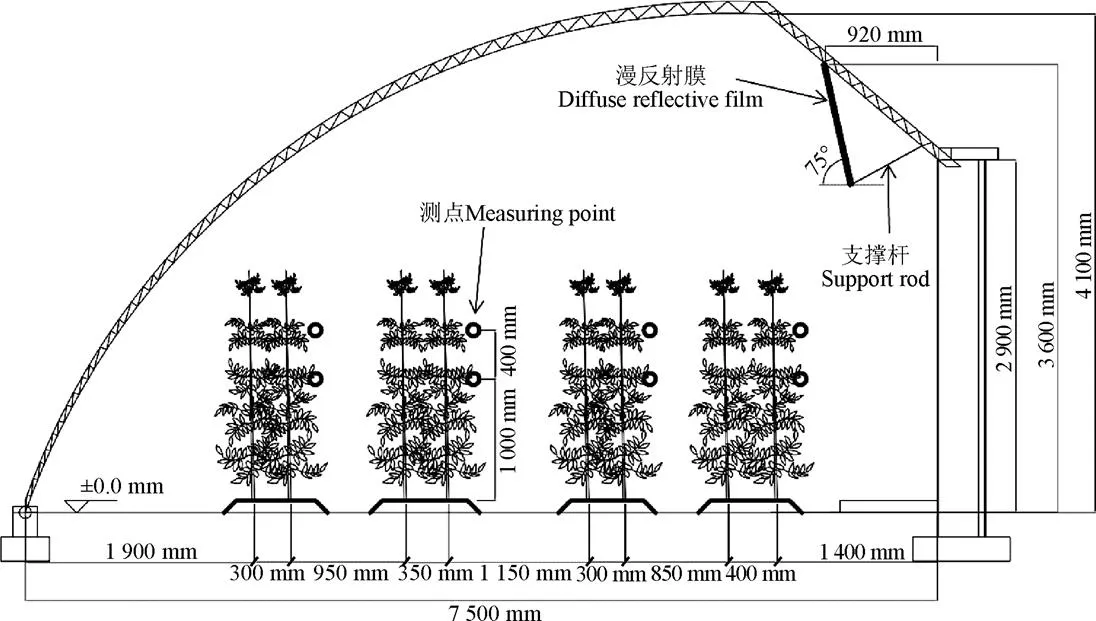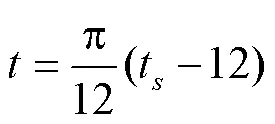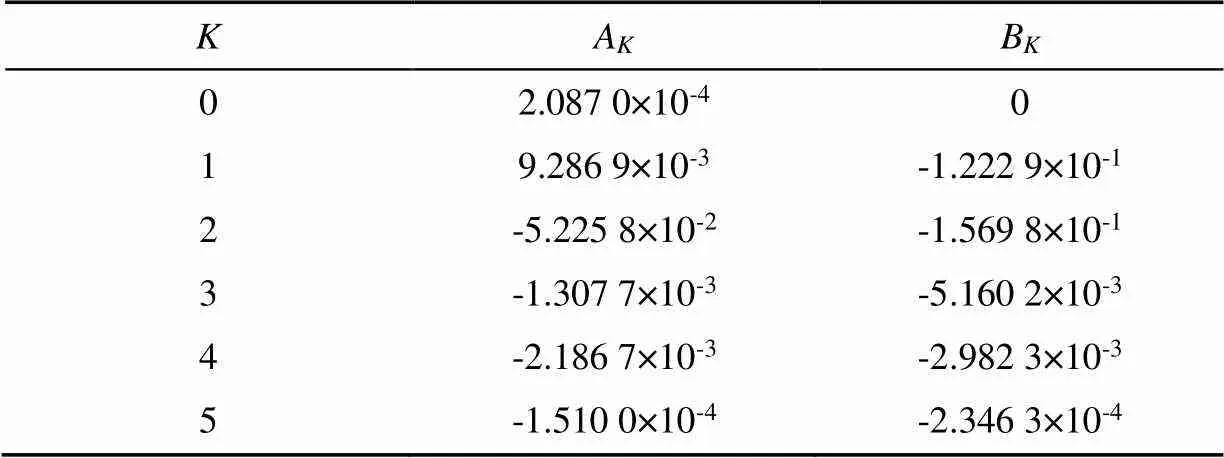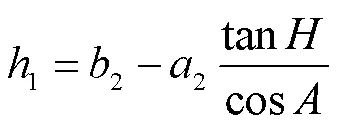日光温室后坡漫反射幕应用方法及效果验证
宋卫堂,孙云博,王平智,郑 亮
•农业生物环境与能源工程•
日光温室后坡漫反射幕应用方法及效果验证
宋卫堂1,2,孙云博1,王平智1,2,郑 亮1,2※
(1. 中国农业大学水利与土木工程学院,北京 100083;2. 农业农村部设施农业工程重点实验室,北京 100083)
日光温室东西垄向栽培可有效提高机械作业效率,但冠层遮挡易造成光照不均,从而影响作物生长发育。针对该问题,该研究提出了适用于日光温室后坡的漫反射幕应用方法,并于试验温室内设置4个东西方向垄,依据理论方法在试验区后坡张挂漫反射幕,以此验证张挂漫反射幕对温室番茄冠层光环境的影响。结果表明:冬季上午,外界光强相对较弱,漫反射幕对冠层光环境的影响较小;中午时,试验区各垄北向来光在冠层1.0和1.4 m高度相比对照组均有显著增强(<0.05),提升10.4%~68.8%,上方来光光强在冠层1.0 m高度相比对照组显著增强(提升16.3%~30.4%,<0.05),在1.4 m高度除第三垄外,影响均不显著(>0.05);下午,与对照区相比,试验区各垄在冠层1.0和1.4 m高度北向来光光强均有增强,最高提升102.0%;相对对照区,试验区第二、三、四垄上方来光光强显著增强(<0.05),提升范围为19.7%~54.3%。因此,漫反射幕可将入射到日光温室后坡的光照反射至各栽培垄北侧,从而改善东西向栽培各垄番茄冠层光照环境。
温室;光照;作物;番茄;漫反射幕
0 引 言
日光温室的传统主栽垄向为南北向,其距离短、行距小、栽培畦数多,造成生产中农机需要频繁更换作业垄行[1],作业“路难走,门难进、边难耕、头难调、效难高”等问题显著,限制了机械化生产效率的提升[2-3]。因此,将日光温室栽培模式改为东西垄向,可方便农机进出、减少转向次数,成为一种有效提高机械作业效率的方法,国内外相关研究表明东西垄向栽培模式可实现番茄产量不低于传统南北垄向[4-7]。然而,采用东西垄向栽培时,由于冠层间遮挡,会造成垄内及垄间光照分布不均:同垄植株南北侧叶片光照不均匀,北侧光强一般弱于南侧[6];不同垄间的光照分布不均匀,尤其北侧垄的光强较弱[7]。
光对植物生长发育与形态建成、及作物产量和品质具有决定性作用,在一定光强范围内,作物产量与受光量成正相关关系[8-11],因而光环境是制约温室作物生产潜力的重要因素[12-13]。通过人工光调控措施,如人工补光、设置反光膜、墙壁刷白等方式越来越多地应用在设施生产中[14]。其中,反光膜张挂简便、成本较低、可控性强,是一种行之有效的温室光环境调控手段[15-16]。设施果树栽培中,采用树下铺设反光膜的措施可以提升叶背的光强,改善果树冠层光环境,在增加产量的同时提升果实品质[17-20]。在日光温室后墙张挂反光膜,也可将照射至北墙的光照部分反射至作物冠层,实现提高冠层北侧光强的目的[21-23]。
然而,由于日光温室后墙兼具蓄热保温功能,尤其在高纬度地区或秋冬季节,若将反光膜张挂在后墙会在一定程度上影响后墙的蓄热功能[21,24-25],而且反光膜张挂在日光温室后墙的可用角度、面积及反射光覆盖区域也受限制。与此相比,日光温室后坡相较后墙的蓄热功能需求较弱,若反光膜安装于后坡,可避免对后墙蓄热功能的影响[25-27],同时方便光反射角度与覆盖范围的调整,将更多太阳辐射反射到植物冠层和土壤,提高进入温室的太阳辐射的利用率,是一种有效的温室光环境调控手段。
此外,尽管传统反射膜可通过反射光照实现光调控的目的,但其增光效果受离反光膜的距离、离地面的高度和作物冠层等因素的影响[25],若使用具备散射光辐射能力的漫反射幕,预期可使反射光照在温室中的覆盖更为均匀[4,28-29]。因此,本文提出在日光温室后坡张挂漫反射幕从而改善温室内光分布的主动采光理论,依据反射光覆盖需求,基于不同纬度、不同时刻的太阳高度角对漫反射幕的张挂角度进行理论构建,并在此基础上进一步开展了漫反射幕设置对东西垄向栽培番茄冠层光环境影响的验证试验。
1 材料与方法
1.1 试验温室
现场试验于2022年2月在北京市房山区弘科农场试验温室(115.97°E,39.62°N)进行。试验温室坐北朝南,东西长75 m,南北跨度7.5 m,南屋面投影宽度6.1 m,后墙高2.9 m,脊高4.1 m,室内北侧硬化道路宽0.8 m;温室后墙采用空心砖和聚苯板双层材料,表面覆盖水泥砂浆,前屋面为轻钢衍架结构,覆盖材料透光率为88.9%、雾度为71.5%。
供试作物为番茄(品种:‘美味红’),2021年9月20日定植,试验期冠层高度为1.8 m。如图1所示,栽培垄从南到北依次编号为第一至第四垄,垄高10 cm,作物采用双行定植,行距分别为30、35、30、40 cm,株距为30 cm,各垄北侧行植株距北墙分别为550、410、265、140 cm。温室东西两侧各留有3.0 m工作缓冲区域。冬季日常管理期间08:30保温被打开,16:00保温被放下。试验区及对照区东西长为各15 m,试验区为温室种植区西侧起15 m,试验区与对照区间设置5 m缓冲区,温室中部15 m种植区域为本试验对照区。试验区后坡按照本文下述方法安装漫反射幕,对照区不安装漫反射幕,其他生产管理措施相同。

图1 日光温室作物栽培模式、漫反射幕安装方式及光环境测点示意图
1.2 冠层光环境测量方法
为检验漫反射幕对作物冠层光照分布的影响,现场试验测量了各垄北侧不同冠层高度的光强。测点布置如图1所示,测点高度分别为垄上1.0和1.4 m,水平方向距各垄冠层北侧10 cm(依据试验温室番茄平均冠幅,各测点距北墙分别为510、380、235、120 cm)。现场试验期间取典型晴天天气条件进行测试,光强使用光照度计(tes-1339,泰仕电子工业有限公司,精确度:±3%)测量。光照测量分为测点的北侧来光及上方来光两方面,其中,北侧来光光强:光照传感器垂直向北放置,与后墙平行;上方来光光强:光照传感器水平向上放置,与后墙垂直。
2 日光温室后坡漫反射幕的应用方法
为合理设置反射光照的覆盖范围和目标中心位置,需依据日光温室所在地理位置、应用季节及时间等参数对漫反射幕的张挂位置、角度、宽度等参数进行理论计算。
2.1 太阳高度角和太阳方位角计算
太阳高度角是某地太阳光线与通过该地与地心相连的地表切面的夹角,随太阳赤纬角和太阳时角的变化而变化。太阳高度角以表示,太阳赤纬角(与太阳直射点纬度相等)以表示,观测地纬度用表示(北纬为正,南纬为负),太阳时角(地方时)以表示,太阳高度角的计算见式(1)。
sin=sin·sin+cos·cos·cos(1)
太阳方位角用表示,其计算式为
cos=(sin·sin−sin)/(cos·cos) (2)
太阳赤纬角()是太阳和地球中心连线与赤道平面的夹角,太阳赤纬角和太阳时角的计算精度直接影响太阳高度角的计算准确性,故分别采用Bourges太阳赤纬角算法[30]和Lamm的时角算法[31]。
太阳赤纬角()计算方法如下:

式中为参考弧度系数(=2π/365.2422);为等效计日序数(=−1−0),为一年内实际的计日序数,表示年份,0为计日序数的修正参数。
0=78.801+[0.2422(−1969)]−int[0.25(−1969)]
太阳时角()算法如下:


式中t为真太阳时;为所在地经度,东经为正;8为北京时间(东八区时间);(equation of time)为真太阳时与平太阳时之间的差值,即时差。
计算方法如下:

式中为一个周期中的计日序数,以闰年开始进行以4 a为周期的循环;A和B为通过非等距傅里叶积分得到待定参数,为其特征标识,取值为0到5,A和B的具体取值见表1。

表1 时差(e)计算中的AK和BK系数[31]
注:A和B为待定参数,为A和B的特征标识(取值为0~5)。
Note: AandBare constant to be defined according to, whereare their identification (0-5).
2.2 漫反射幕张挂参数的计算方法
2.2.1 漫反射幕的张挂角度
漫反射幕张挂于日光温室后坡,设此时上边缘与后墙水平距离为1、高度为1、漫反射幕宽度为。当漫反射幕与水平面夹角为时,漫反射幕直射光反射光落点与后墙距离为1,反射点与垄面距离为1。根据空间位置,可得反射光落点、漫反射幕安装位置与太阳位置间关系式如下:

此时,漫反射幕下边缘与后墙距离2和高度2分别为


漫反射幕下边缘反射光落点与后墙距离(2)与高度(2)之间的关系式如下:

在不同栽培条件和不同季节的日光温室,可根据需求调节漫反射幕主要作用区域,选择合适的漫反射幕张挂角度。同时根据作用区域的计算,可判断漫反射幕是否充分利用进入温室的太阳辐射,避免将太阳辐射反射至温室外部、温室走廊和后墙等无效辅助区域。
2.2.2 漫反射幕的宽度选择
根据漫反射幕在后坡的安装位置,可计算漫反射幕对后墙遮光的范围,即计算漫反射幕在后墙形成的阴影区域,由此可选择合适的漫反射幕宽度。可简化计算其下边缘在后墙位置的投影高度1。

投影高度1的最优选择为与后墙高度相同,此时即充分利用了后坡的太阳辐射,又对后墙的储热功能影响最小。
2.3 试验日光温室漫反射幕参数及其安装方法
如图2现场照片所示,本试验所采用漫反射幕为定制珍珠棉镀铝薄膜,其镀铝层表面呈不规则竖条状突起,可在保证反光效果的同时将入射光反射至多个角度,形成漫反射效果。试验日光温室所用漫反射幕采用框架固定,并依据安装高度及安装角度需求安装在试验区后坡。
根据试验温室所处纬度及试验季节,时钟时间(地方时)为12:00时,时差为−0.23 h,太阳高度角为38.02°,太阳方位角为0°。以日光温室内后墙与水平地面交点为原点,为水平坐标,为垂直坐标,本试验所期待的中心反射点为第四垄上部(=−140 cm,=190 cm)。本试验所用漫反射幕总长度15 m,宽度1.0 m,依据上述漫反射幕安装理论方法及试验温室实际工况,其安装要求为上边缘距垄面高360 cm、距后墙92 cm,所得漫反射幕中心位置高度为305 cm、与后墙距离82 cm,计算得漫反射幕张挂理论角度为77°,为安装便利,实际漫反射幕安装角度为75°(图1,图2)。16:00时(即下午保温被落下时间)太阳高度角为13.92°、太阳方位角为60.66°,计算此时漫反射幕上边缘反射光落点距后墙3.8 m,在温室内部,且主要反射光落点区域仍为后两垄,故可采用此张挂角度。

图2 日光温室后坡张挂漫反射幕
3 结果与分析
3.1 日光温室内太阳入射及反射区域
图3a所示为上午08:30时试验日光温室内太阳入射角度及反射光线位置的示意图,此时太阳高度角为31°,漫反射幕所反射光照的直射光部分光线的理论覆盖范围为作物第三垄北侧及第四垄冠层上部位置。图3b所示为中午(12:00)时太阳光入射角度及反射光线的示意图,此时,漫反射幕所散射光照的直射光部分光线的理论覆盖范围为作物第四垄。图3c为下午(15:30)时入射光线与漫反射幕反射光线示意图,同上午一样,此时反射光线的直射光部分集中于第四垄冠层上部和第三垄冠层北侧。

图3 不同时间日光温室内太阳入射及反射光线位置示意图
3.2 上午冠层不同位置的光照分布
图4a、图4b为上午08:30日光温室内不同栽培垄北侧的北向来光光强对比。在冠层1.0 m高度(图4a),第三垄试验区与对照区无显著性差异,其余垄试验区垄北侧光强显著低于对照区(<0.05),但其光强差值仅为2.4~10.2 μmol/(m2×s)。在冠层1.4 m高度(图4b),第一、四垄试验区和对照区无显著性差异,第二、三垄试验区北侧来光光强相对于对照区光强显著增加(≤0.01);相比对照区,第二垄光强提高了7.8 μmol/(m2×s),光强提升12.0%;第三垄的北向来光光强相对于对照区提高了20.8 μmol/(m2×s),提升52.9%。试验区和对照区第二、三、四垄在冠层1.0和1.4 m高度的北向来光光强均低于第一垄。
图4c、图4d为上午08:30日光温室内不同栽培垄北侧的上方来光光强对比。在冠层1.0 m高度(图4c),第一垄的上方来光光强试验区低于对照区11.8%,第二垄上方来光光强试验区相比对照区提升22.4%,第三、四垄上方来光光强无显著差异。在冠层1.4 m高度(图4d),第二垄上方来光光强试验区显著高于对照区,提高了63.6 μmol/(m2×s),相对对照区提升22.3%,其余各垄上方来光光强无显著差异。整体来看,上方来光光强从南到北减弱,在冠层1.0和1.4 m高度上,均为第一垄光强最高,分别为272.4、378.0 μmol/(m2×s)。1.0 m高度对照区和试验区第三垄的上方来光相较第一垄的对照区分别低44.0%、44.4%,第四垄的上方来光光强相较第一垄分别低61.2%和68.7%,光强降低范围约120~180 μmol/(m2×s);1.4 m高度的第三垄和第四垄光强相比于第一垄的降低分别45%和67%,降低量为170~255 μmol/(m2×s)。

注:不同字母代表同一垄上试验区与对照区光强有显著性异(P<0.05). PPFD:光合光子通量密度,μmol·m-2·s-1。下同。
由于作物间遮挡及温室结构的反射作用,日光温室内各垄的光照水平存在一定差异[7,12]。本研究中,上午(08:30)对照区在冠层1.0和1.4 m高度的北向来光和上方来光的光强均呈现为由南到北降低的趋势,该结果与前人的研究结果一致[7,16,21]。本研究所设置光照测点位于各栽培垄北侧(图1),测点光照来源主要为环境散射光和其北侧垄植株及北侧墙体(后坡及后墙)的反射光。由于上午太阳高度角较低条件下的冠层遮挡[32],故温室内各栽培垄光照呈现出该趋势。通过漫反射幕后,试验区的测点光强变化主要发生在1.4 m高度的第二及第三垄,既漫反射幕的主要反光覆盖区域,对于其他冠层高度及栽培垄的影响不大。其原因在于,漫反射幕与原后坡材料相比,其反射率更高,但漫反射率相对要小,布置漫反射幕后,让上午温室后坡区域的光照相对集中地反射到了其目标区域。
3.3 中午冠层不同位置的光照分布
图5a、图5b为中午(12:00)时各栽培垄的北向来光的光强对比。在冠层1.0及1.4 m高度,试验区光强相比于对照区均有显著提高(<0.05),提高范围为10.4%~68.8%;在反射光的作用下,第三垄试验区相较对照区光强增强最多,分别提升52.4%和68.8%。在无张挂漫反射幕的情况下(对照区),在1.0和1.4 m冠层高度第一、二、三垄的北向来光光强较低,第四垄的光强相比前三垄均显著提高(<0.01),分别达到158.4和172.2 μmol/(m2×s),相较第一垄分别提高44.3%和33.0%(图5a~5b)。与对照区相比,在后坡增加漫反射幕处理(试验区)后,试验区1.0和1.4 m冠层高度北向来光从南到北逐渐增强,第三、四垄的光强显著高于第一、二垄(<0.01),1.0 m高度光强分别为168.7、181.0 μmol/(m2×s),相较对照区第一垄光强分别提高58.9%和71.3%;1.4 m高度光强分别为205.1和221.8 μmol/(m2×s),相较对照区第一垄提高75.6%和92.3%。
图5c、图5d分别为中午(12:00)时各垄北侧上方来光的光强。在冠层1.0 m高度,试验区光强相对于对照区均显著提高(提升16.3%~30.4%,<0.05),其中试验区第三垄北侧的北向来光光强达到525.0 μmol/(m2×s),相比对照区提升最多,提升幅度达30.4%,试验区第三、四垄上方来光光强相比对照区第一垄光强分别95和120 μmol/(m2×s),提升幅度为29.1%和23.5%。在冠层1.4 m高度,相比于对照区,试验区第三垄光强显著提高(<0.01),光强提高27.1%(图5d)第一、第二、第四垄试验区与对照区无显著差异(>0.05)。在1.0及1.4 m冠层高度,对照区、试验区内各垄间上方来光光强对比无显著性差异。
漫反射幕的应用在中午时刻(12:00)对提高冠层光辐射强度、改善光分布有明显效果。中午,冠层光透射量较高,第三、四垄靠近温室后墙,后墙反射的部分光照提高了其北向来光光强[22]。漫反射幕的反射光照的理论覆盖范围落在第三、四垄,因而其上方来光光强与前两垄差异不大,漫反射幕加强了温室北侧墙体(后墙和后坡)的反光效果,增加漫反射幕后,各垄北侧冠层1.0 m高度的光环境改善最明显,4个栽培垄的光强均有提高;1.4 m高度的垄北侧各垄间冠层光强差别不大,但漫反射幕显著提高了第三垄垄北侧冠层的光强,改善了原来第三垄光环境较前两垄差的问题。

图5 中午(12:00)日光温室内不同栽培垄光强
3.4 下午冠层不同位置的光照分布
图6a、图6b为下午(15:30)时各垄冠层北侧的北向来光光强对比。在冠层1.0和1.4 m高度,试验区光强相比于对照区各垄均有显著提高(<0.05)。对照区在1.0和1.4 m高度第一、第二、第三垄北向来光光强无显著差异(>0.05),第四垄显著高于其余三垄(<0.01),其光量子流密度达到88.7和101.2 μmol/(m2×s),相较第一垄光强分别提高49.6%和41.4%。在后坡张挂漫反射幕后,试验区在1.0和1.4 m冠层高度北向来光光强呈从南到北增强的趋势,第三垄光强相对对照区提升最多,分别提升69.2%和102.0%;图6c、图6d为下午各垄北侧的上方来光光强对比。在冠层1.0和1.4m高度,第一垄试验区和对照区的光强无显著差异,第二、三、四垄的试验区光强相比于对照区均有显著提高。1.0 m高度,对照区内各垄间上方来光光强无显著性差异;安装漫反射幕后,试验区光强第二、第三、第四垄试验区光强均高于对照区,并呈现由南到北增强的趋势,第四垄光强最高,达到289.4 μmol/(m2×s),相较对照区提升46.0%。1.4 m高度,对照区第一垄的光强显著高于其他三垄(=0.02),为318.5 μmol/(m2×s),增加漫反射幕后,第二、三、四垄的光强均有显著提升(提升19.7%~54.3%,<0.05),试验区第四垄光强最高,为427.0 μmol/(m2×s),相较对照区提升54.3%。
下午,室外光辐射强度也相对较高,对照区在各垄间光强差异不显著,靠近后墙的第四垄,与中午的结果相似,由于温室后墙的反射作用,北向来光光强较高。漫反射幕的应用显著提升了各垄及各高度的北侧来光光强,同时,由于漫反射幕的散射入射光照的作用,使得试验区第二、三、四垄的上方来光光强得到相应的提高。

图6 下午(15:30)日光温室内不同栽培垄光强
4 结 论
1)在日光温室后坡布置漫反射幕,可充分利用进入温室内的太阳辐射,改善东西垄向栽培日光温室的光环境。本研究所设置漫反射幕主要作用目标区域为第三及第四垄,试验区第三垄北向来光和上方来光光强相比于对照区提升幅度最高,在1.0和1.4 m冠层高度,中午的光强提升幅度分别在52.4%和27.1%以上。漫反射幕的作用可使反射光照覆盖至更广的第一、第二垄,相比于对照区,试验区各垄在中午和下午的北向来光光强在1.0和1.4 m冠层高度均显著提高(<0.05),提升幅度在10.4%以上。
2)依据本研究所提出的日光温室后坡漫反射幕应用方法,可实现根据日光温室所处纬度和建筑参数、漫反射幕位置和时点计算漫反射幕的使用规格和张挂角度等参数,为利用漫反射幕改善日光温室作物冠层光环境提供了参考。本研究所采用漫反射幕安装角度相对固定,后期研究可应用本文方法开发动态调整装置;漫反射幕相对于传统反光膜的反射光覆盖范围更宽泛,后期可进一步对漫反射幕的反光率及漫反射比例进行理论分析,实现光照均匀性的进一步提升。
[1] 宋卫堂. 日光温室蔬菜生产全程机械化的一种解决方案[J]. 中国农机化学报,2018,39(9):26-29.
SONG Weitang. A complete mechanization solution for greenhouse vegetable production[J]. Journal of Chinese Agricultural Mechnization, 2018, 39(9): 26-29. (in Chinese with English abstract)
[2] 余朝阁,何尧,岳红岩,等. 东北地区日光温室果菜生产现状与轻简化途径[J]. 中国蔬菜,2022(4):88-92.
YU Chaoge, HE Yao, YUE Hongyan, et al. Production status of fruit vegetables in solar greenhouse of northeast region and simplification pathway[J]. China Vegetable, 2022(4): 88-92. (in Chinese with English abstract)
[3] 宋卫堂. 设施蔬菜产业发展对机械化的需求[J]. 中国农机化学报,2017,38(11):112-115.
SONG Weitang. Demands of the development of protected vegetable industry on mechanized[J]. Journal of Chinese Agricultural Mechanization, 2017, 38(11): 112-115. (in Chinese with English abstract)
[4] 宋卫堂,李晨曦,孙旭光,等. 散射膜日光温室中种植垄向对番茄生长和产量的影响[J]. 农业工程学报,2017,33(24):242-248.
SONG Weitang, LI Chenxi, SUN Xuguang, et al. Effects of ridge direction on growth and yield of tomato in solar greenhouse with diffuse film[J]. Transactions of the Chinese Society of Agricultural Engineering (Transactions of the CSAE), 2017, 33(24): 242-248. (in Chinese with English abstract)
[5] 陈真真,李仪曼,栾恒,等. 垄向和株行距配置对日光温室番茄生育及产量的影响[J]. 山东农业科学,2022,54(3):63-67.
CHEN Zhenzhen, LI Yiman, LUAN Heng, et al. Effects of ridge direction and plant and row spacing on growth and yield of tomato in solar greenhouse[J]. Shandong Agricultural Sciences, 2022, 54(3): 63-67. (in Chinese with English abstract)
[6] 李治国,闫子双,杨立国,等. 农机农艺融合的日光温室番茄栽培模式试验研究[J]. 中国农机化学报,2021,42(6):55-59.
LI Zhiguo, YAN Zishuang, YANG Liguo, et al. Experimental study on tomato cultivation mode in solar greenhouse based on integration of agricultural machinery and agronomy[J]. Journal of Chinese Agricultural Mechnization, 2021, 42(6): 55-59. (in Chinese with English abstract)
[7] 杨冬艳,桑婷,冯海萍,等. 种植密度对日光温室东西垄向栽培番茄产量构成及光环境的影响[J]. 河南农业科学,2021,50(5):99-106.
YANG Dongyan, SANG Ting, FENG Haiping, et al. Effects of planting density on yield composition and light environment of east-west ridge of tomato in greenhouse[J]. Journal of Henan Agricultural Sciences, 2021, 50(5): 99-106. (in Chinese with English abstract)
[8] PARADISO R, PROIETTI S. Light-quality manipulation to control plant growth and photomorphogenesis in greenhouse horticulture: The state of the art and the opportunities of modern LED systems[J]. Journal of Plant Growth Regulation, 2022, 41: 742-780.
[9] FU Y, LI H Y, YU J, et al. Interaction effects of light intensity and nitrogen concentration on growth, photosynthetic characteristics and quality of lettuce (L. Var. youmaicai)[J]. Scientia horticulturae, 2017, 214: 51-57.
[10] POORTER H, NIINEMETS Ü, NTAGKAS N, et al. A meta-analysis of plant responses to light intensity for 70 traits ranging from molecules to whole plant performance[J]. New Phytologist, 2019, 223(3): 1073-1105.
[11] FARALLI M, LAWSON T. Natural genetic variation in photosynthesis: An untapped resource to increase crop yield potential?[J]. Plant Journal, 2020, 101(3): 518-528.
[12] 吴毅明,曹永华,孙忠富,等. 温室采光设计的理论分析方法:设施农业光环境模拟分析研究之一[J]. 农业工程学报,1992,8(3):73-80.
WU Yiming, CAO Yonghua, SUN Zhongfu, et al. An analytical method of light transmissivity in greenhouse design: The first part of serial studies in simulation of light environment in protected cultivation[J]. Transactions of the Chinese Society of Agricultural Engineering (Transactions of the CSAE), 1992, 8(3): 73-80. (in Chinese with English abstract)
[13] CHAVAN S G, MAIER C, Alagoz Y, et al. Light-limited photosynthesis under energy-saving film decreases eggplant yield[J]. Food and Energy Security, 2020, 9: e245.
[14] 于海业,孔丽娟,刘爽,等. 植物生产的光环境因子调控应用综述[J]. 农机化研究,2018,40(8):1-9.
YU Haiye, KONG Lijuan, LIU Shuang, et al. The application of lighting environment control technology in plant production[J]. Journal of Agricultural Mechanization Research, 2018, 40(8): 1-9. (in Chinese with English abstract)
[15] LIU Anhua, HENKE M, LI Yiming, et al. Investigation of the impact of supplemental reflective films to improve micro-light climate within tomato plant canopy in solar greenhouses[J]. Frontiers in Plant Science, 2022, 13: 966596.
[16] 王静,崔庆法,林茂兹. 不同结构日光温室光环境及补光研究[J]. 农业工程学报,2002,18(4):86-89.
WANG Jing, CUI Qingfa, LIN Maozi. Illumination environment of different structural solar greenhouses and their supplement illumination[J]. Transactions of the Chinese Society of Agricultural Engineering (Transactions of the CSAE), 2002, 18(4): 86-89. (in Chinese with English abstract)
[17] 吴瑞媛,陈露露,王涛,等. 反光膜对大棚‘翠冠’梨果实糖积累及蔗糖代谢相关酶活性的影响[J]. 果树学报,2013,30(3):427-432.
WU Ruiyuan, CHEN Lulu, WANG Tao, et al. Effects of reflective film on sugar accumulation and sucrose-metabolizing enzymes in fruit of ‘Cuiguan’ pear cultivated in plastic tunnel[J]. Journal of Fruit Science, 2013, 30(3): 427-432. (in Chinese with English abstract)
[18] 张卓,王磊,陈秋菊,等. 铺设反光膜对日光温室甜樱桃果实品质的影响初报[J]. 上海交通大学学报(农业科学版),2019,37(4):24-28.
ZHANG Zhuo, WANG Lei, CHEN Qiuju, et al. Effect of reflective film on fruit quality of sweet cherry (cv. ‘Tieton’) in solar greenhouse[J]. Journal of Shanghai Jiaotong University (Agricultural Science), 2019, 37(4): 24-28. (in Chinese with English abstract)
[19] MEYER G E, PAPAROZZI E T, WALTER-SHEA E A, et al. An investigation of reflective mulches for use over capillary mat systems for winter-time greenhouse strawberry production[J]. Applied Engineering in Agriculture, 2012, 28(2): 271-279.
[20] YOU S, LIU H, LI Z, et al. Soil environment and spectra properties coregulate tomato growth, fruit quality, and yield in different colored biodegradable paper mulching during the summer season[J]. Scientia Horticulturae, 2021, 275: 109632.
[21] 韦峰,江力,张亚红. 日光温室后屋面内设反光幕环境效应分析[J]. 黑龙江农业科学,2014(8):71-77.
WEI Feng, JIANG Li, ZHANG Yahong. Environmental effect analysis on sunlight greenhouse roof with reflective film[J]. Heilongjiang Agricultural Sciences, 2014(8): 71-77. (in Chinese with English abstract)
[22] 崔庆法,曹春晖,胡小进,等. 日光温室内反光膜补光的实践与理论探析[J]. 中国生态农业学报,2005,13(1):82-84.
CUI Qingfa, CAO Chunhui, HU Xiaojin, et al. Practice and theoretic analysis of supplementing illumination in the solar greenhouse with reflecting film[J]. Chinese Journal of Eco-Agriculture, 2005, 13(1): 82-84. (in Chinese with English abstract)
[23] 周礼. 重庆日光温室反光幕曲面计算与模拟研究[D]. 重庆:西南大学,2012.
ZHOU Li. Calculating and Simulating the Shapes of Reflecting Film of Sunlight Greenhouses in Chongqing[D]. Chongqing: Xinan University, 2012. (in Chinese with English abstract)
[24] CHEN C, YU N, YANG F, et al. Theoretical and experimental study on selection of physical dimensions of passive solar greenhouses for enhanced energy performance[J]. Solar Energy, 2019, 191: 46-56
[25] 韩亚东. 辽沈日光温室能量平衡方程中几个主要分量模拟模型的构建[D]. 沈阳:沈阳农业大学,2015.
HAN Yadong. Establishing Main Components Modelling of Energy Balance Equation in Liaoshen Solar Greenhouse[D]. Shenyang: Shenyang Agricultural Univerisity, 2015. (in Chinese with English abstract)
[26] 韩亚东,薛学武,罗新兰,等. 日光温室内太阳辐射估算模型的构建[J]. 农业工程学报,2014,30(10):174-181.
HAN Yadong, XUE Xuewu, LUO Xinlan, et al. Establishment of estimation model of solar radiation within solar greenhouse[J]. Transactions of the Chinese Society of Agricultural Engineering (Transactions of the CSAE), 2014, 30(10): 174-181. (in Chinese with English abstract)
[27] 马承伟,卜云龙,籍秀红,等. 日光温室墙体夜间放热量计算与保温蓄热性评价方法的研究[J]. 上海交通大学学报(农业科学版),2008,26(5):411-415.
MA Chengwei, BU Yunlong, JI Xiuhong, et al. Method for calculation of heat release at night and evaluation for performance of heat preservation of wall in solar greenhouse[J]. Journal of Shanghai Jiaotong University (Agricultural Science), 2008, 26(5): 411-415. (in Chinese with English abstract)
[28] LAMNATOU C, CHEMISANA D. Solar radiation manipulations and their role in greenhouse claddings: Fluorescent solar concentrators, photoselective and other materials[J]. Renewable and Sustainable Energy Reviews, 2013, 27: 175-190.
[29] CHENT W, HENKE M, DE VISSER P H B, et al. What is the most prominent factor limiting photosynthesis in different layers of a greenhouse cucumber canopy?[J] Annals of Botany, 2014, 114(4): 677-688.
[30] BOURGES B. Improvement in solar declination computation[J]. Solar Energy, 1985, 35(4): 367-369.
[31] LAMM L O. A new analytic expression for the equation of time[J]. Solar Energy, 1981, 26(5): 465.
[32] 唐佳宁,陈启峰,余朝阁,等. 东西垄丛栽方式对日光温室秋冬茬番茄生长及其温光环境的影响[J]. 中国农学通报,2022,38(30):65-71.
TANG Jianing, CHEN Qifeng, YU Chaoge, et al. Effects of east and west ridge cluster cultivation on the growth of autumn and winter tomato and the temperature and light environment in solar greenhouse[J]. Chinese Agricultural Science Bulletin, 2022, 38(30): 65-71. (in Chinese with English abstract)
Application and effect verification of diffuse reflective films on the backslope of solar greenhouses
Song Weitang1,2, Sun Yunbo1, Wang Pingzhi1,2, Zheng Liang1,2※
(1.,100083,; 2.,,100083,)
The east-west ridge cultivation technique can effectively improve the mechanical operation efficiency in the solar greenhouses. However, the generally dimmed canopy can be found in the north side of the solar greenhouse and the north side of each ridge, compared with the south side. This study aims to improve the light environment inner tomato canopy, particularly for the better growth and development of the cultivated crops. A theoretical method was proposed to hang the diffused reflective film on the back slope of the solar greenhouse, according to the geographical location and building parameters. The appropriate angle was also determined for the diffused reflective film on the light environment of the greenhouse. The field test was conducted in the solar greenhouse of Hongke Farm (115.97E, 39.62N) in Beijing of China in February of 2022. Four east-west ridges were set in the experimental greenhouse. The greenhouse was separated as an experimental and control section. Among them, a diffuse reflective film with an appropriate angle was hung on the back slope of the solar greenhouse. The tomato plants were managed in the experimental and control sections, according to the normal horticultural practice. The light sensors were placed horizontally upward to measure the light intensity from above at the 1.0 and 1.4 m height of the canopy on the north side of the ridge, respectively. By contrast, the sensors were placed vertically backward to record the light intensity from the north side at 1.0 and 1.4 m height of the canopy. The results showed that the effect of the diffuse reflective film on the canopy light intensity was relatively low in the morning, due to the relatively low light intensity and the greater sun azimuth. At noon, the application of diffuse reflective film was improved the light intensity from the north of each ridge, compared with the control, while the light intensity from the north at 1.0 and 1.4 m increased by 52.4% and 68.8% for the third ridge, respectively. The overall light intensity at the 1.0 m height of the canopy increased for all the ridges. At the height of 1.4 m, only the light intensity of the third ridge at the experimental section was significantly higher than that of the control, and the light intensity increased by 27.1%. In the afternoon, the light intensity from the north of each ridge also increased, and the third ridge increased the greatest, while the light intensity from the north direction increased by 69.2% and 102.0%, respectively, compared with the control. The light intensity of the incoming light from above of the second, the third and the fourth ridge were all significantly increased, and the fourth ridge was resulted in the greatest improvement, indicating both the optimal heights of 1.0, and 1.4 m (46.0% and 54.3%, respectively). Therefore, the diffused reflective film can be expected to increase the light intensity of the inner canopy, providing for the incoming light from the north side. As such, the illumination uniformity of the greenhouse can increase to improve the light environment in the greenhouse.
greenhouse; light; crops; tomato; diffuse reflective film
10.11975/j.issn.1002-6819.202208209
S214.9
A
1002-6819(2023)-01-0171-08
宋卫堂,孙云博,王平智,等. 日光温室后坡漫反射幕应用方法及效果验证[J]. 农业工程学报,2023,39(1):171-178.doi:10.11975/j.issn.1002-6819.202208209 http://www.tcsae.org
SONG Weitang, SUN Yunbo, WANG Pingzhi, et al. Application and effect verification of diffuse reflective films on the backslope of solar greenhouses[J]. Transactions of the Chinese Society of Agricultural Engineering (Transactions of the CSAE), 2023, 39(1): 171-178. (in Chinese with English abstract) doi:10.11975/j.issn.1002-6819.202208209 http://www.tcsae.org
2022-08-20
2022-12-26
现代农业产业技术体系建设专项资金项目(CARS-23-D02);山东省自然科学基金资助项目(ZR2021QC099)
宋卫堂,博士,教授,研究方向为设施园艺工程。Email:songchali@cau.edu.cn
郑亮,博士,讲师,研究方向为设施园艺工程。Email:zhengliang@cau.edu.cn

